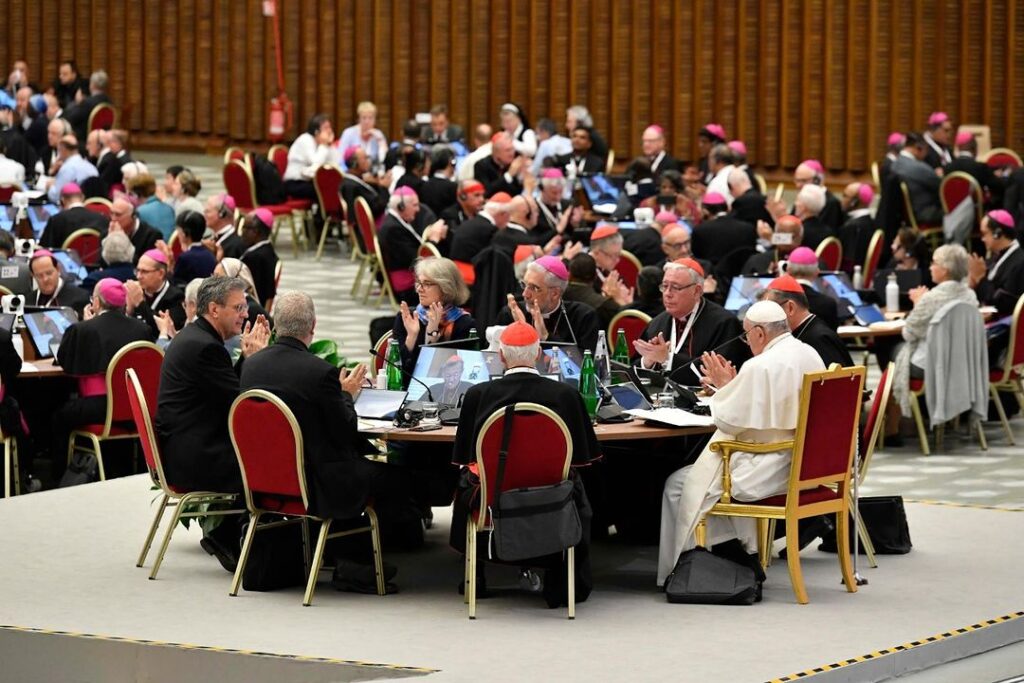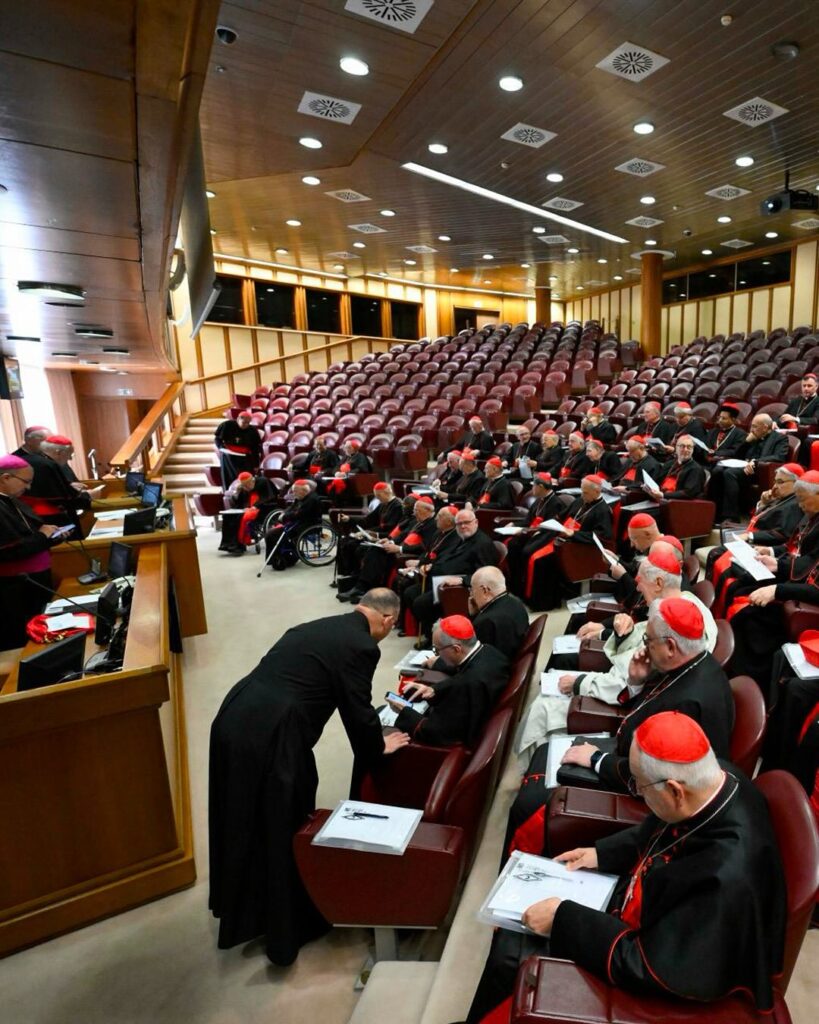A Church on mission
Instrumentum Laboris of the Synod

The text will guide the work of the second session of the XVI Ordinary General Assembly, scheduled for October 2 to 27. The document is in continuity with the entire synodal process initiated in 2021 and presents proposals for a Church that is increasingly “synodal in mission”, closer to the people and in which all the baptized participate in its life. Among the points of reflection are the valorization of women and the need for transparency and accountability.
How to be a missionary synodal Church? This is the basic question from which the Instrumentum laboris (IL) of the next session of the Synod of Bishops, scheduled for October 2 to 27, the second of the XVI Ordinary General Assembly, after that of 2023. The IL – published today, Tuesday, July 9, and presented in the Press Office of the Holy See – does not offer “prefabricated answers”, but rather “indications and proposals” on how the Church, as a whole, can respond “to the need for to be ‘synodal in mission'”, that is, a Church closer to the people, less bureaucratic, that is the house and family of God, in which all the baptized are co-responsible and participate in their lives in the distinction of their different ministries. and roles.
DOWNLOAD THE INSTRUMENTUM LABORIS IN SPANISH BY CLICKING HERE
The five parts of the document
The document is structured in five sections: introduction, foundations and three central parts. The introduction recalls the path traveled so far and highlights the milestones already achieved, such as the generalization of the synodal methodology of the Conversation in the Spirit. This is followed by the foundations (nn. 1-18) that focus on the understanding of synodality, seen as a path of conversion and reform. In a world marked by divisions and conflicts, it is emphasized, the Church is called to be a sign of unity, an instrument of reconciliation and an attentive ear for all, especially for the poor, the marginalized, the minorities removed from power.
Value women in the Church
The foundations also dedicate ample space (n.13-18) to reflection on the role of women in all areas of the life of the Church, underlining “the need to give fuller recognition” to their charismas and her vocation. “God has chosen some women to be the first witnesses and heralds of the resurrection,” recalls the IL; They, therefore, “by virtue of Baptism, are in a condition of complete equality, receive the same outpouring of gifts of the Spirit and are called to serve the mission of Christ.”
Participation and responsibility
In some cultures, it emerges from the IL, “the presence of machismo remains strong”; For this reason, the second synodal session is asked for “a broader participation of women in the processes of ecclesial discernment and in all phases of the decision-making processes” along with “broader access to positions of responsibility in dioceses and in ecclesiastical institutions”, as well as in seminaries, institutes, theological faculties and “in the role of judge in canonical processes”. The suggestions also refer to consecrated women, for whom “greater recognition and more determined support” for their lives and charisms are expected, along with “their employment in positions of responsibility.”
Theological reflection continues on the female diaconate
Regarding the admission of women to the diaconal ministry, the IL reports that it is requested by “some local Churches”, while others “reiterate their opposition” (n. 17). The topic, it is noted, “will not be the subject of the work” next October, so it is good that “theological reflection continues.” In any case, the reflection on the role of women “highlights the desire for a strengthening of all the ministries exercised by the laity”, for whom it is asked that “properly trained they can also contribute to the preaching of the Word of God also during the celebration of the Eucharist” (no. 18).
Part I – Relationships with God, between brothers and between Churches
After the introduction and the foundations, the IL stops at the relationships (nn. 22-50) that allow the Church to be synodal in the mission, that is, the relationships with God the Father, between brothers and between the Churches. Charisms, ministries and ordained ministries are, therefore, essential in a world and for a world that, in the midst of so many contradictions, seeks justice, peace and hope. From the local Churches also emerges the voice of young people who demand a Church not of structures or bureaucracy, but one founded on relationships that inspire and live in dynamics and paths. In this perspective, the October Assembly will be able to analyze the proposal to give life to new ministries, such as “listening and accompanying.”
Part II – Formative paths and community discernment
These relationships must be developed Christianly along itineraries (n. 51-79) of formation and “community discernment”, which allow the Churches to make appropriate decisions, articulating the responsibility and participation of all. “The intertwining of generations is a school of synodality,” states the IL, “everyone, the weak and the strong, the children, the young and the elderly, have much to receive and much to give” (n. 55).
The importance of accountability
But among the paths to follow are also those that allow those who have ecclesial responsibilities to be transparently accountable for their actions for the good and mission of the Church. “A synodal Church needs a culture and practice of transparency and accountability,” reads the IL, “which are indispensable to foster the mutual trust necessary to walk together and exercise co-responsibility in the common mission” (n. 73).
A credible Church requires transparency and accountability
Recalling then that “accountability for one’s own ministry to the community belongs to the oldest tradition, dating back to the Apostolic Church” (n. 74), the working document emphasizes that today “the demand for transparency and Accountability in and by the Church has become necessary as a consequence of the loss of credibility due to financial scandals and, especially, sexual and other abuse of minors and vulnerable people. The lack of transparency and accountability fuels the clericalism” (n. 75), which is mistakenly based on the assumption that ordained ministers are accountable to no one for the exercise of their authority.
Evaluation structures are needed
Responsibility and transparency, the IL insists, concern all levels of the Church and are not limited to the area of sexual and financial abuse, but also affect “pastoral plans, methods of evangelization and the way in which “The Church respects the dignity of the human person, for example with regard to working conditions in its institutions” (no. 76). Hence the request for “necessary structures and forms of evaluation – understood in a non-moralistic sense – of the way in which ministerial responsibilities of all kinds are exercised” (n. 77). In this regard, the document recalls the need for the Church to guarantee, for example, the publication of an annual report both on the management of goods and resources and on the performance of the mission, including “an illustration of the initiatives undertaken in the field of safeguarding (protection of minors and vulnerable people) and the promotion of women’s access to positions of authority and their participation in decision-making processes” (n. 79).
Part III – The places of ecumenical and interreligious dialogue
The IL next analyzes the places (n. 80-108) in which relationships and paths take shape. Places that must be understood not simply as spaces, but rather as concrete contexts, characterized by cultures and the dynamisms of the human condition. Inviting us to overcome a static vision and a pyramidal image of ecclesial relationships and experiences, the working document rather recognizes their variety and plurality, which allow the Church – one and universal – to live in dynamic circularity “in places and from places”, without falling into particularism or flattening. On the contrary: it is precisely in this horizon thus outlined where the great themes of ecumenical, interreligious and cultural dialogue must be inserted. In this context, the search for forms of exercise of the Petrine ministry open to the “new situation” of the ecumenical path, towards the visible unity of Christians (n. 102 and 107).
Pilgrims of hope
Finally, the document recalls how each of the questions it contains wants to be a service to the Church and an opportunity to heal the deepest wounds of our time. For this reason, the Instrumentum laboris concludes with an invitation to continue the journey as “pilgrims of hope”, also in the perspective of the Jubilee of 2025 (n. 112).
Source: Vatican News
Related

The first General Congregation of Cardinals was held in the Vatican
Exaudi Staff
23 April, 2025
2 min

Holy See: Canonization of Carlo Acutis Postponed
Exaudi Staff
21 April, 2025
2 min

Baptism: An Indelible Mark on the Soul
Exaudi Staff
19 April, 2025
1 min

Antoni Gaudí Takes Another Step Toward the Altar: Declared Venerable by the Church
Exaudi Staff
14 April, 2025
2 min
 (EN)
(EN)
 (ES)
(ES)
 (IT)
(IT)

